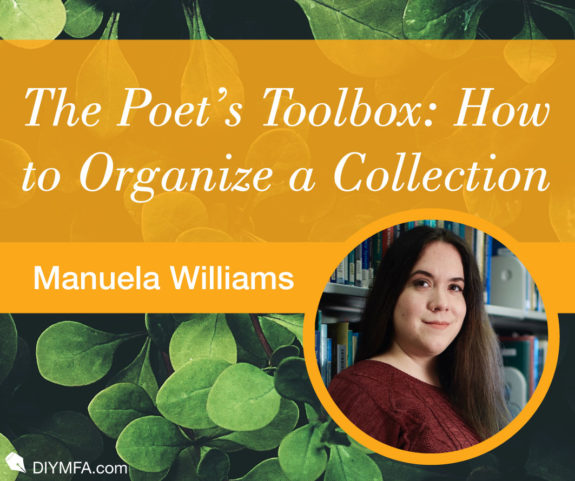Welcome back, poets! In my last article, I talked about some of the techniques I use to generate ideas and inspiration for poems, especially when on a deadline. Today, I want to take things a step further and talk about what to do after you’ve written and revised a bunch of poems, and are ready to start thinking about how to organize a collection of your poetry—either to submit to presses or contests, for self-publishing, or for friends and family.
A full-length poetry collection is typically between 50 and 98 pages. Sometimes a little more, sometimes a little less. If you have fewer than 50 pages, you’ll be looking at a chapbook manuscript, which is typically between 25 and 30 pages. If you’re thinking about submitting your manuscript to presses or contests, make sure you keep these page ranges in mind, as some presses specifically request chapbooks (as opposed to full-length manuscripts) and vice-versa.
It can be challenging to compile and organize a collection of poetry. Depending on your material, you won’t always have a clear beginning, middle, and end like a novel might.
However, despite not being novels or short stories, I think some of the best poetry collections still have some kind of developmental arc.
Maybe, like the original arrangement of Sylvia Plath’s Ariel, they trace the breakup of a marriage before ending with the images of spring, hope, and renewal. Or maybe, like Kim Addonizio’s Jimmy and Rita, the collection serves as a novel in verse, tracking the development and relationship between the two title characters.
The arrangement of poems in a collection shouldn’t be random. Instead, think of the individual poems, through their arrangement, as working together to create larger meaning. When readers finish the last poem in your collection, what message do you want them to take away from the collection as a whole (as opposed to the messages of individual poems)?
Here are some ways to think about arranging your poems to maximize the larger ideas and messages as you organize a collection.
Start with Your Strongest Poems
Generally, when readers pick up your collection, they begin by reading the first few poems to determine whether to keep reading or not (very similar to readers of novels and short stories!). So it’s always a good idea to start your collection off with your strongest work. Think of the first few poems as your “hook.” If you don’t hook your readers early enough, they’ll put your book down.
It might also be helpful to think about your first few poems as teaching your reader how the rest of your collection will unfold.
What major themes will you be exploring? What problems will your collection address?
Organize a Collection by Narrative Arc or Emotional Development
If you find the majority of your poems revolve around a similar theme, event, or problem, consider arranging your poems in a way that mirrors a more traditional narrative arc, with a beginning, middle, and end.
For example, let’s say you’ve written a series of poems about the death of a close family member. You could potentially arrange the collection in three different parts—poems that focus on the time before the family member’s death (perhaps developing the speaker’s relationship with the family member), poems that deal directly with the death, and, finally, poems that deal with the aftermath of death. This is a very rough outline, but it does show a narrative arc.
Another option could be to focus on emotional development. You might focus on how a speaker (or multiple speakers) develop over the course of a collection. To use the Sylvia Plath example from above, if you’re writing about the breakdown of a relationship, you could start from a place of endings and brokenness and move towards a sense of wholeness and hope.
Organize a Collection by Theme or Subject Matter
If your poems are more varied, consider arranging them by theme or subject matter. That said, in order to ensure your collection feels cohesive, make sure your themes are connected in some way.
For example, if the main theme of your collection is loss, you might consider sections containing poems that deal with loss in different ways. If you write nature poetry, you could consider arranging the poems based on setting, or even season.
If you find that your poems are a little too varied—to the point where the transitions between poems or sections feels jarring—you might need to cut some poems that don’t necessarily fit with the major themes of the collection.
And that’s okay!
This happened to me a lot when I was preparing a first draft of my own poetry manuscript. Although I absolutely loved some of the poems individually, I ended up having to cut them because they didn’t really fit with the narrative arc I had planned for the collection.
Again, this is totally normal, and it doesn’t mean that you have to scrap the poem or poems entirely. Perhaps they can be a part of a different manuscript!
Experiment!
The tips and tricks I’ve given above are pretty traditional and they definitely shouldn’t be viewed as hard and fast rules. Don’t be afraid to try out more experimental arrangements for your collection. The poems in Like by A.E. Stallings are arranged in alphabetical order, for example, and Tommy Pico’s IRL doesn’t contain individual poems or sections at all, rather, the collection is composed of one long poem!
Have fun with it and, remember, you can always keep rearranging your collection until you’re 100% happy with it.

Manuela Williams lives and writes in Nevada. She is the author of two poetry chapbooks and one paranormal fiction novella. When she’s not writing, Manuela loves reading romance novels, drinking *all* the coffee, and playing video games.







